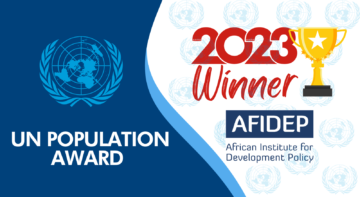Blogs

It is estimated a whopping 750,000 Kenyan youth attempt to join the labour market annually but only about 15 percent of them are successful in securing formal jobs.
A new study by the African Institute for Development Policy (AFIDEP) and the University of Southampton (UK) analysing youth demographics in the East African Community (EAC) suggests that unemployment in Kenya is marked by inequality and discrimination. The report shall be released at a public event on 20 June 2018 at the Movenpick Hotel in Nairobi, presided by Dr. Josephine Kibaru-Mbae, the Director-General of the National Council for Population and Development (NCPD). Overall, Kenya’s youth unemployment is higher than national unemployment average: 17.7 percent of youth are unemployed, where the national rate is 7.4 percent. Further, 21 percent of female youth are unemployed compared to 17 percent of their male counterparts.
Recent surveys have specifically signaled that access to gainful employment and income opportunities for young people in Kenya is hindered by corruption, the lack of capital, information, and relevant skills, among other factors. Further, when young people are employed, most tend to be engaged in the vulnerable and low-paying informal Jua Kali sector in urban areas, while those in the rural areas are often underemployed, particularly in the subsistence agricultural sector. As a result, the working youth receive wages that are inadequate for their needs and most are not covered by any social protection programmes.
The study also points out that a significant number of Kenyan youth are neither in education, employment, nor in any sort of training. This measure is also known as the NEET rate. During the 2013 Kenya Steps Skills Survey, the NEET rate for youth aged 15-34 years was estimated at 29 percent, meaning close to 5 million Kenyan youth were not in education, employment or training in 2015. Assuming that this rate remains constant, it is estimated that this number could increase to 7 million by 2030 and 9 million by 2050. In the survey, female youth were disproportionally represented within the group at 42 percent, significantly higher than males at 14 percent, further confirming that access to employment and opportunities for obtaining a living in Kenya are cut along age and gender lines.
The International Labour Organisation (ILO) points out that youth who are not in education, employment or training, are especially at risk since they are neither improving their future employability through investments in vital skills nor gaining work experience through employment. As a result, this group faces the real danger of being shut out of the labour market and being excluded in society. Consequently, these young people are likely to be caught up in a poverty trap or potentially become a destabilising force that can be used to cause civil disturbance or become a recruitment pool for terrorism and other criminal activities. These youth may also form a pool of desperate potential labour migrants, a phenomenon that has played out in African countries with similar youth demographics, leading to not only a loss of human capital on the continent but also have them fall prey to human trafficking in the pursuit of a better life abroad.
These challenges are characteristic of what happens when a country’s rapidly growing young population manifests as an obstacle to socio-economic growth rather than as drivers of an economic boom, when governments and other key stakeholders fail to take the necessary measures to tap into their potential.
Kenya has a large youthful population. The Kenya Constitution of 2010 defines youth as those aged between 18 and 34 years old. This proportion of the youth constitutes 25 percent of Kenya’s total population, while those below 15 years make up 43 percent. This large youthful population is as a result of very high fertility, which over a 30-year period, has reduced by only three children per woman to 3.9 in 2015. As such, most Kenyan households struggle to support large families, as there are more dependents than those earning income. This often leads to long-term undermining effects such as trapping generations in a poverty cycle as households are unable to save “ an important factor that enables investments and the accumulation of wealth for the future.
A window of opportunity
However, despite the challenges posed by the magnitude of Kenya’s youthful population, there is still a window of opportunity for Kenya to accelerate its socio-economic development, but only if it makes the right investment choices to take advantage of its youth demographics. The first step to harnessing this potential is providing adequate sexual and reproductive health information and services so as to reduce Kenya’s high fertility, and in turn, reduce the current high dependency burden. Fertility is the most influential determinant of population change in Kenya, and fewer dependents will bring about an economic benefit for the country, as the resources that would have paid for education, health, and basic services for large numbers of children can be re-invested for longer-term economic growth and capital development, a phenomenon commonly referred to as the demographic dividend.
However, the demographic dividend is neither guaranteed nor automatic. This study cites Tunisia and South Africa as notable examples of countries that have failed to maximise their demographic dividend despite transitioning to a population age structure with significantly more people in the working ages than dependents. To maximise the promise of this dividend, Kenya must also invest in the development of its human capital through policies and actions that expand the education and skills development opportunities afforded to the youth; the provision of an enabling economic environment; and the creation of adequate numbers of decent jobs that will be distributed to the youth and working-age adults without discrimination.
If little is done to alleviate Kenya’s rapid population growth rate, the proportion of young dependents will continue to overwhelm the productive workers, placing a significant strain on the country’s resources as they still have to be educated, housed, employed and provided with healthcare. Inaction in addressing Kenya’s youth demographics may eventually threaten the country’s security as unemployed, disenchanted and marginalised youth can cause civil and political unrest. This has already been witnessed in many parts of the world such as Northern Africa and in the Middle-East with the Arab Spring uprising, which was spearheaded by young people, and whose aftermath has proved more problematic than the conditions that brought it on in the first place.
– –
The study East African Regional Analysis of Youth Demographics is available at (http://bit.ly/2JSEld7)
For interviews and additional information on the study, please contact:
Bernard Onyango, Ph.D.,
Knowledge Translation Scientist,
African Institute for Development Policy (Nairobi, Kenya)
Related Posts





